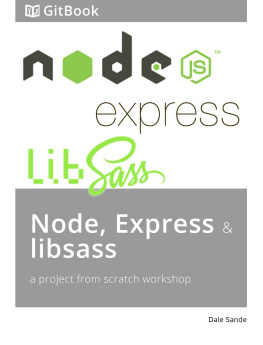it-ebooks - Build a Node.js Project from Scratch
Here you can read online it-ebooks - Build a Node.js Project from Scratch full text of the book (entire story) in english for free. Download pdf and epub, get meaning, cover and reviews about this ebook. year: 2018, publisher: iBooker it-ebooks, genre: Computer. Description of the work, (preface) as well as reviews are available. Best literature library LitArk.com created for fans of good reading and offers a wide selection of genres:
Romance novel
Science fiction
Adventure
Detective
Science
History
Home and family
Prose
Art
Politics
Computer
Non-fiction
Religion
Business
Children
Humor
Choose a favorite category and find really read worthwhile books. Enjoy immersion in the world of imagination, feel the emotions of the characters or learn something new for yourself, make an fascinating discovery.
Build a Node.js Project from Scratch: summary, description and annotation
We offer to read an annotation, description, summary or preface (depends on what the author of the book "Build a Node.js Project from Scratch" wrote himself). If you haven't found the necessary information about the book — write in the comments, we will try to find it.
Build a Node.js Project from Scratch — read online for free the complete book (whole text) full work
Below is the text of the book, divided by pages. System saving the place of the last page read, allows you to conveniently read the book "Build a Node.js Project from Scratch" online for free, without having to search again every time where you left off. Put a bookmark, and you can go to the page where you finished reading at any time.
Font size:
Interval:
Bookmark:
Errors are already addressed in Express for you. In the app.js file, there is the following:
/// catch 404 and forwarding to error handler app.use( function (req, res, next) { var err = new Error ( 'Not Found' ); err.status = ; next(err);});Then in the views/ dir, there is errors.jade.
extends layoutblock content h1= message h2= error.status pre #{error.stack}Simple. If you want to customize your 404 page, simply edit this view.
From 0 - 60, build a contact widget From 0 - 60, build a contact widget.
The following demo is a re-do of a popular UI/UX pattern of revealing the form label as the user enters data into the form.
Great demo that adds the next layer of awesome to this workshop. Adding a Mongo DB to the project to make a simple i/o UX.
My favorite thing about MongoDB is that it uses JSON for its structure, which means it was instantly familiar for me. If you're not familiar with JSON, you'll need to do some reading, as I'm afraid that's outside the scope of this tutorial.
Let's add a record to our collection. For the purposes of this tutorial, we're just going to have a simple database of usernames and email addresses. Our data format will thus look like this:
{ "_id" : 1234 , "username" : "cwbuecheler" , "email" : "cwbuecheler@nospam.com" }Anyone out there willing to help put the rest of this together, I would love a Pull Request!
Now that we know the powers of Bower to easily manage our front-end development dependencies, what do we need to do to add a Bower package of Sass code to our project?
First off, let's install a simple Bower package for illustration:
$ bower install css-calc-mixin --saveThere, we now have the library of code in our project.
Next we want to update the Gruntfile.js so that we can easily include the library into our Sass files. Without this step, we would need to write fill paths in our Sass file to this and that's simply lame.
In the Grunt-Sass API we have options and the one we need to use is includePaths. Here we can pass in a string that is the full path from root to the Bower package into an array.
module .exports = function (grunt) { grunt.initConfig({ sass: { dist: { files: { 'public/stylesheets/style.css' : 'sass/style.scss' } }, options: { includePaths: [ './bower_components/css-calc-mixin' ] } }, watch: { source: { files: [ 'sass/**/*.scss' , 'views/**/*.jade' ], tasks: [ 'sass' ], options: { livereload: true , // needed to run LiveReload } } } }); grunt.loadNpmTasks( 'grunt-contrib-watch' ); grunt.loadNpmTasks( 'grunt-sass' ); grunt.registerTask( 'default' , [ 'sass' ]);};To make use of this new Bower package library, we simply need to use a Sass convention to import the code.
@import "css-calc-mixin";To test that this is working, let's add a little bit of code that references the Bower library.
.block { @include calc(width, 220px);}.block { @include calc(margin, 220px, 0);}.block { @include calc(width, 220px, true, 0);}.block { @include calc(width, 220px, true, 0, 50%, '+');}Back in the CLI, run grunt and we should see green lights all day long!
Unless you live in a hole, you are well aware that the JavaScript revolution is all around us. Many of the amazing concepts I discovered in the Rails ecosystem are now bursting out into the JavaScript space allowing for a greater distribution of awesome. The three pillars are; Yeoman, Bower and Grunt.
The problem I need to solve is; what is the best way to get some library code up on Github and make it easily accessible to users without having to clone the project? Because, that's pretty lame, right?
Initially I came across generator-sass-boilerplate, a 'Yeoman generator for quickly scaffolding out Sass styles'. This is a very interesting approach for creating a complex library and allowing the user to customize the install. But for a simpler library of code, maybe just some functions and mixins, this is way to much overhead.
Fast forward to now. I recently came across new posts that really break down what Bower is and what it is best at. And it hit me, this IS the answer!
For those not in the know, Bower is an extremely simple solution for front-end package management.
It offers a generic, unopinionated solution to the problem of front-end package management, while exposing the package dependency model via an API that can be consumed by a more opinionated build stack.
The beauty of Bower is held within it's simplicity. Bower has a registry, but it's not 100% necessary. The common command is bower install where can refer to a large number of options, thus making it dirt simple to just share some code. NICE!
Sticking with the 'dirt simple' theme, you can use Bower to easily pull a repo into your project without having to clone it. Even if it doesn't have a bower.json file.
For example Stipe, a Compass Extension library I wrote, is not Bower aware at all.
$ bower install git://github.com/Toadstool-Stipe/stipe.gitRun that command in any folder and you will pull in the entire repo with no Github history. This alone is pretty interesting.
To get started, it's simple really. Assuming that Node and npm is installed on your local box, run:
$ npm install -g bowerI won't go into exhaustive detail here, but 99% of the time you simply need to run:
$ bower installAs stated above, there are alternate install options, but the primary solution is to have a bower.json file in the repo and have it registered with Bower.
If you have a bower.json file in your project, explained in the next section, you can add the --save flag with the install and this will add the library as a dependency in your project. Sweet.
When you distribute the project, a user who clones it only has to run $ bower install and it will pull in all the external resources. Nice!
This new system of creating and distributing resources raises an interesting question; do you commit all your bower packages or not? In the Ruby world, Gems are not actually part of the project, but dependencies of the project, and never committed to the project's version control. In this new JavaScript world, Node and Bower package dependencies are referenced via a manifest, much like the Gemfile in Ruby, but are actually installed into the root of the project directory.
There is a whole discussion on this topic. I look at it this way, when you install a Bower library, are you leaving this as a dependency or are you making modifications?
The choice is up to you, the arguments are strong on either side. In a situation where you are actually forking the code you installed, then the answer is pretty clear, it should be committed to the project or you need to fork the dependency.
Creating a new Bower package is again, really simple.
Font size:
Interval:
Bookmark:
Similar books «Build a Node.js Project from Scratch»
Look at similar books to Build a Node.js Project from Scratch. We have selected literature similar in name and meaning in the hope of providing readers with more options to find new, interesting, not yet read works.
Discussion, reviews of the book Build a Node.js Project from Scratch and just readers' own opinions. Leave your comments, write what you think about the work, its meaning or the main characters. Specify what exactly you liked and what you didn't like, and why you think so.














